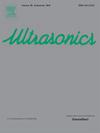低强度脉冲超声通过抗氧化应激机制缓解小鼠糖尿病周围神经病变
IF 3.8
2区 物理与天体物理
Q1 ACOUSTICS
引用次数: 0
摘要
糖尿病周围神经病变(DPN)是糖尿病最常见的并发症之一,给患者带来巨大的疼痛和经济负担。目前,由于血糖控制只是一种预防,药物治疗只是缓解DPN疼痛,尚无有效的治疗方法。低强度脉冲超声(LIPUS)作为一种非侵入性的物理治疗方法,被广泛应用于肌肉骨骼和神经损伤的治疗。研究表明LIPUS可以通过氧化应激途径的机械刺激使神经再生,这被认为是DPN的重要因素,可能在DPN的治疗中具有潜力。本研究旨在确定使用LIPUS治疗DPN的新策略。分析LIPUS对小鼠DPN的治疗效果,探讨其治疗机制。本研究采用动物实验,将C57BL/6J小鼠随机分为DPN模型组和Sham组。DPN模型组大鼠饲喂高脂饲料,连续3 d注射链脲佐菌素(STZ) (40 mg/kg/d), Sham组大鼠饲喂正常饲料,注射等体积柠檬酸钠缓冲液。经84天造模过程确认DPN模型后,将DPN小鼠随机分为DPN组和LIPUS组。LIPUS组超声治疗中心频率为1 MHz,占空比为20%,空间平均时间平均强度(ISATA)为200 mW/cm2,持续20 min/d, 5 d/w。治疗56天后,所有小鼠均被安乐死。通过空腹血糖(FBG)测量、行为测试、氧化应激测试、形态学分析、免疫荧光和western blot分析来评估LIPUS的治疗效果。结果表明,DPN小鼠FBG水平(28.77±2.95 mmol/L)明显高于假手术小鼠(10.31±1.49 mmol/L)。此外,DPN小鼠的机械阈值(4.13±0.92 g)明显低于假药小鼠(7.31±0.83 g, 11.67±1.21 s),热潜伏期(16.20±2.39 s)明显高于假药小鼠(11.67±1.21 s)。LIPUS组葡萄糖曲线下面积(AUC)较DPN组(AUC = 3271±420.90 min*mmol/L)降低(AUC = 2452±459.33 min*mmol/L)。行为学实验显示,LIPUS治疗可显著缓解DPN引起的异常,其机械阈值从DPN组的2.79±0.79 g提高到LIPUS组的5.50±1.00 g,热潜伏期从DPN组的12.38±1.88 s显著降低到LIPUS组的9.49±2.31 s。形态学观察显示DPN小鼠的髓鞘变薄且形状不规则,LIPUS组的坐骨神经神经纤维异常率为61.04±5.60%,而LIPUS组的神经纤维异常率为49.76±4.88%。此外,LIPUS治疗使相关神经再生蛋白(即Nf200)的平均荧光强度从DPN组的27.81±0.32任意单位增加到LIPUS组的37.62±0.36任意单位。Western blot和免疫荧光分析显示,LIPUS处理显著降低Keap1的相对表达量为0.04±0.06个单位,而DPN组为0.17±0.30个单位。此外,免疫荧光分析显示,LIPUS处理促进其下游抗氧化蛋白血红素加氧酶-1 (HO-1)的产生,荧光强度从DPN组的27.81±0.32任意单位增加到LIPUS处理组的37.62±0.36任意单位。LIPUS组Nrf2的荧光强度明显升高,从DPN组的4.90±0.25任意单位增加到LIPUS处理组的15.18±2.13任意单位。此外,血清中氧化应激指标丙二醛(MDA)水平显著降低,从DPN组的5.40±0.48 nmol/ml降至LIPUS处理组的4.64±0.16 nmol/ml,坐骨神经从16.17±5.88 nmol/mg蛋白降至4.67±2.10 nmol/mg蛋白,表明LIPUS抑制了氧化应激。本研究首次证实LIPUS可通过抗氧化应激过程缓解DPN。本研究提示LIPUS可能是一种新的DPN治疗策略。本文章由计算机程序翻译,如有差异,请以英文原文为准。
Low-intensity pulsed ultrasound relieved the diabetic peripheral neuropathy in mice via anti-oxidative stress mechanism
Diabetic peripheral neuropathy (DPN), as one of the most prevalent complications of diabetes, leads to significant pain and financial burden to patients. Currently, there was no effective treatment for DPN since the glucose control was just a prevention and the drug therapy only relieved the DPN pain. As a non-invasive physical therapy, low-intensity pulsed ultrasound (LIPUS) is utilized in the musculoskeletal and nerve injuries therapy. Studies revealed that LIPUS could regenerate nerves by the mechanical stimulation via oxidative stress pathway, which was thought as the important factor for DPN, and might have potential in the DPN therapy. This study aimed to identify a new therapeutic strategy for DPN using LIPUS. We analyzed the therapy effect and explored the therapeutic mechanism of LIPUS on DPN in mice.
This study involved animal experiments and C57BL/6J mice were randomly assigned to DPN model and Sham groups. The DPN model group was fed a high-fat chow diet and injected with streptozotocin (STZ) for 3 consecutive days (40 mg/kg/d), whereas the Sham group was fed a normal diet and injected with an equal volume of sodium citrate buffer. After the DPN model confirmed with the 84-day modeling process, the DPN mice were randomly allocated into the DPN group and the LIPUS group. The LIPUS group underwent ultrasound treatments with a center frequency of 1 MHz, a duty cycle of 20 %, and a spatial average temporal average intensity (ISATA) of 200 for 20 min/d, 5 d/w. After the 56-day treatment, all mice were euthanized. LIPUS therapeutic effects were evaluated through measurements of fasting blood glucose (FBG), behavioral tests, oxidative stress tests, morphological analysis, immunofluorescence, and western blot analysis.
The results indicated that DPN mice had significantly higher FBG levels (28.77 ± 2.95 mmol/L) compared with sham mice (10.31 ± 1.49 mmol/L). Additionally, DPN mice had significantly lower mechanical threshold (4.13 ± 0.92 g) and higher thermal latency (16.20 ± 2.39 s) compared with the sham mice (7.31 ± 0.83 g, 11.67 ± 1.21 s). After receiving LIPUS treatment, the glucose tolerance tests (GTT) suggested that LIPUS treatment improved glucose tolerance, which was shown by a decrease in the area under the curve (AUC) for glucose in the LIPUS group (AUC = 2452 ± 459.33 min*mmol/L) compared with the DPN group (AUC = 3271 ± 420.90 min*mmol/L). Behavioral tests showed that LIPUS treatment significantly alleviated DPN-induced abnormalities by improving the mechanical threshold from 2.79 ± 0.79 g in the DPN group to 5.50 ± 1.00 g in the LIPUS group, and significantly decreasing thermal latency from 12.38 ± 1.88 s in the DPN group to 9.49 ± 2.31 s in the LIPUS group. Morphological observations revealed that DPN mice had a thinning and irregularly shaped myelin sheath, with 61.04 ± 5.60 % of abnormal nerve fibers in the sciatic nerve in LIPUS group, compared with 49.76 ± 4.88 % of abnormal nerve fibers in the LIPUS-treated group. Additionally, LIPUS treatment increased the mean fluorescence intensity of the associated nerve regeneration protein (i.e., Nf200) from 27.81 ± 0.32 arbitrary units in the DPN group to 37.62 ± 0.36 arbitrary units in the LIPUS group. Western blot and immunofluorescence analysis showed that LIPUS treatment significantly reduced Keap1 expression to 0.04 ± 0.06 relative units, compared with 0.17 ± 0.30 in the DPN group. Furthermore, immunofluorescence analysis revealed that LIPUS treatment promoted the production of its downstream antioxidant protein, heme oxygenase-1 (HO-1), with an increase in the fluorescence intensity from 27.81 ± 0.32 arbitrary units in the DPN group to 37.62 ± 0.36 arbitrary units in the LIPUS-treated group. The fluorescence intensity of Nrf2 was significantly higher in the LIPUS group, increasing from 4.90 ± 0.25 arbitrary units in the DPN group to 15.18 ± 2.13 arbitrary units in the LIPUS-treated group. Additionally, the malondialdehyde (MDA) levels, an indicator of oxidative stress, were significantly reduced in the serum, from 5.40 ± 0.48 nmol/ml in the DPN group to 4.64 ± 0.16 nmol/ml in the LIPUS-treated group, and in the sciatic nerve, from 16.17 ± 5.88 nmol/mg protein to 4.67 ± 2.10 nmol/mg protein, suggesting the oxidative stress was inhibited by LIPUS.
This study demonstrated for the first time that LIPUS could relive DPN through anti-oxidative stress process. This study suggests that LIPUS might be a new therapy strategy for DPN.
求助全文
通过发布文献求助,成功后即可免费获取论文全文。
去求助
来源期刊

Ultrasonics
医学-核医学
CiteScore
7.60
自引率
19.00%
发文量
186
审稿时长
3.9 months
期刊介绍:
Ultrasonics is the only internationally established journal which covers the entire field of ultrasound research and technology and all its many applications. Ultrasonics contains a variety of sections to keep readers fully informed and up-to-date on the whole spectrum of research and development throughout the world. Ultrasonics publishes papers of exceptional quality and of relevance to both academia and industry. Manuscripts in which ultrasonics is a central issue and not simply an incidental tool or minor issue, are welcomed.
As well as top quality original research papers and review articles by world renowned experts, Ultrasonics also regularly features short communications, a calendar of forthcoming events and special issues dedicated to topical subjects.
 求助内容:
求助内容: 应助结果提醒方式:
应助结果提醒方式:


